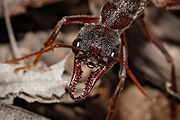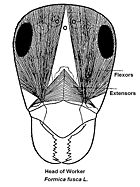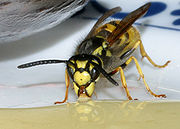
Mandible (insect)
Encyclopedia

Insect
Insects are a class of living creatures within the arthropods that have a chitinous exoskeleton, a three-part body , three pairs of jointed legs, compound eyes, and two antennae...
mandibles are a pair of appendages near the insect’s mouth, and the most anterior of the three pairs of oral appendages (the labrum is more anterior, but is a single fused structure). Their function is typically to grasp, crush, or cut the insect’s food, or to defend against predators or rivals. Insect mandibles, which appear to be evolutionarily derived from legs, move in the horizontal plane unlike those of vertebrates, which appear to be derived from gill arches and move vertically.
Grasshoppers, crickets, and other simple insects
The mouthparts of orthopteraOrthoptera
Orthoptera is an order of insects with paurometabolous or incomplete metamorphosis, including the grasshoppers, crickets and locusts.Many insects in this order produce sound by rubbing their wings against each other or their legs, the wings or legs containing rows of corrugated bumps...
n insects are often used as a basic example of mandibulate (chewing) mouthparts, and the mandibles themselves are likewise generalized in structure. They are large and hardened, shaped like pinchers, with cutting surfaces on the distal portion and chewing or grinding surfaces basally. They are usually lined with teeth and move sideways. Large pieces of leaves can therefore be cut and then pulverized near the actual mouth opening. This same simple structure is seen in all of the remaining Polyneopteran insect orders, with the exception of the Paraneoptera
Paraneoptera
Paraneoptera is a monophyletic superorder of insects which includes four orders, the bark lice, true lice, thrips, and hemipterans, the true bugs. The mouthparts of the Paraneoptera reflect diverse feeding habits...
(Hemiptera
Hemiptera
Hemiptera is an order of insects most often known as the true bugs , comprising around 50,000–80,000 species of cicadas, aphids, planthoppers, leafhoppers, shield bugs, and others...
, Thysanoptera, and Phthiraptera). Likewise, the mandibles of adult and larval Odonata
Odonata
Odonata is an order of insects, encompassing dragonflies and damselflies . The word dragonfly is also sometimes used to refer to all Odonata, but the back-formation odonate is a more correct English name for the group as a whole...
are simple and generalized, while Ephemeroptera rarely feed as adults, though the larvae ("nymphs") have simple mandibles.
True bugs
The HemipteraHemiptera
Hemiptera is an order of insects most often known as the true bugs , comprising around 50,000–80,000 species of cicadas, aphids, planthoppers, leafhoppers, shield bugs, and others...
, and other insects whose mouthparts are described as piercing-sucking, have modified mandibles. Rather than being tooth-like, the mandibles of such insects are lengthened into stylets, which form the outer two parts of the feeding tube, or beak. The mandibles are therefore instrumental in piercing the plant or animal tissues upon which these insects feed, and in helping draw up fluids to the insect’s mouth.They are also described as mandibles.
Beetles

Beetle
Coleoptera is an order of insects commonly called beetles. The word "coleoptera" is from the Greek , koleos, "sheath"; and , pteron, "wing", thus "sheathed wing". Coleoptera contains more species than any other order, constituting almost 25% of all known life-forms...
s, and many beetle larvae, have mandibles. In general form they are similar to those of grasshoppers: hardened and tooth-like.
Beetle mandibles show a remarkable amount of variability between species, and some are very highly adapted to the food sources or other uses that the species has for them. Certain firefly
Firefly
Lampyridae is a family of insects in the beetle order Coleoptera. They are winged beetles, and commonly called fireflies or lightning bugs for their conspicuous crepuscular use of bioluminescence to attract mates or prey. Fireflies produce a "cold light", with no infrared or ultraviolet frequencies...
larvae (family Lampyridae) that feed on snails have grooved mandibles that not only physically break down their prey, but also deliver digestive fluids by these grooves. Ground beetle
Ground beetle
Ground beetles are a large, cosmopolitan family of beetles, Carabidae, with more than 40,000 species worldwide, approximately 2,000 of which are found in North America and 2,700 in Europe.-Description and ecology:...
s (family Carabidae) of the tribe Cychrini have long mandibles that project far in front of them, which aid them in feeding on snails inside their shells.
Members of the stag beetle
Stag beetle
Stag beetles are a group of about 1,200 species of beetle in the family Lucanidae, presently classified in four subfamilies Some species grow up to over 12 cm , but most are about 5 cm .-Overview:...
family (Lucanidae) have greatly enlarged mandibles that are often forked, resembling the horns of various deer
Deer
Deer are the ruminant mammals forming the family Cervidae. Species in the Cervidae family include white-tailed deer, elk, moose, red deer, reindeer, fallow deer, roe deer and chital. Male deer of all species and female reindeer grow and shed new antlers each year...
, from which their common name comes, and similar mofications appear in various scarab beetles
Scarabaeidae
The family Scarabaeidae as currently defined consists of over 30,000 species of beetles worldwide. The species in this large family are often called scarabs or scarab beetles. The classification of this family is fairly unstable, with numerous competing theories, and new proposals appearing quite...
and longhorn beetle
Longhorn beetle
The longhorn beetles are a cosmopolitan family of beetles, typically characterized by extremely long antennae, which are often as long as or longer than the beetle's body...
s. Males of these beetles use their mandibles to grasp or displace each other as they compete for mates
Sexual selection
Sexual selection, a concept introduced by Charles Darwin in his 1859 book On the Origin of Species, is a significant element of his theory of natural selection...
.
Thrips
Thysanoptera (thripsThrips
Thrips are tiny, slender insects with fringed wings . Other common names for thrips include thunderflies, thunderbugs, storm flies, thunderblights, and corn lice...
) have a variation of piercing mouthparts. In this order only the left mandible is present, modified into a stylet.
Neuropteroids
Within the NeuropteridaNeuropterida
The Neuropterida are a clade of holometabolous insects. Well-known members are the lacewings, antlions and dobsonflies.Historically, they were known as Neuroptera, but this name nowadays refers to lacewings and their relatives only, which formerly were known as Planipennia...
, adults have chewing mouthparts, but the mandibles of male dobsonflies
Dobsonfly
A Dobsonfly is any insect of the subfamily Corydalinae, part of the megalopteran family Corydalidae. There are over 220 species of dobsonflies. Dobsonflies are found throughout the Americas and Asia, as well as South Africa...
are non-functional in feeding. The larvae in many lineages are predatory, with mandibles modified with grooves along which digestive saliva flows, while the larvae of the family Sisyridae
Sisyridae
The Sisyridae, commonly known as spongeflies or spongillaflies, is a family of winged insects of the order Neuroptera. Approximately 60 living species are known.-Description:...
have the mouthparts developed into a sucking tube which they use to feed on the liquid tissues of freshwater sponge
Sea sponge
Sponges are animals of the phylum Porifera . Their bodies consist of jelly-like mesohyl sandwiched between two thin layers of cells. While all animals have unspecialized cells that can transform into specialized cells, sponges are unique in having some specialized cells, but can also have...
s.
Ants, bees, and wasps


Hymenoptera
Hymenoptera is one of the largest orders of insects, comprising the sawflies, wasps, bees and ants. There are over 130,000 recognized species, with many more remaining to be described. The name refers to the heavy wings of the insects, and is derived from the Ancient Greek ὑμήν : membrane and...
have mandibles that follow the general form, as in grasshoppers. The mandibles are used to clip pieces of vegetation, gather wood fibers, dig nests, or to capture and disassemble prey. What is unusual is that many Hymenoptera have the remaining mouthparts modified to form a proboscis
Proboscis
A proboscis is an elongated appendage from the head of an animal, either a vertebrate or an invertebrate. In simpler terms, a proboscis is the straw-like mouth found in several varieties of species.-Etymology:...
(a "tongue" used to feed on liquids), making them virtually the only insects that normally possess both chewing mouthparts and sucking mouthparts (a few exceptional members of other orders may exhibit this, such as flower-feeding beetles that also have "tongues").
Flies
Several families of fliesDiptera
Diptera , or true flies, is the order of insects possessing only a single pair of wings on the mesothorax; the metathorax bears a pair of drumstick like structures called the halteres, the remnants of the hind wings. It is a large order, containing an estimated 240,000 species, although under half...
, notably mosquito
Mosquito
Mosquitoes are members of a family of nematocerid flies: the Culicidae . The word Mosquito is from the Spanish and Portuguese for little fly...
es (family Culicidae), have mandibles that are modified into stylets for piercing, similar to the true bugs.
Flies of the Muscomorpha
Muscomorpha
The Brachyceran infraorder Muscomorpha is a large and diverse group of flies, containing the bulk of the Brachycera, and, in fact, most of the known flies. It includes a number of the most familiar flies, such as the housefly, the fruit fly and the blowfly. The antennae are short, usually...
, including the house fly
Housefly
The housefly , Musca domestica, is a fly of the suborder Cyclorrhapha...
, Musca domestica, stable fly
Stable fly
Stomoxys calcitrans is commonly called the stable fly, barn fly, biting house fly, dog fly, or power mower fly. Unusually for a member of the family Muscidae, but like other members of the genus, Stomoxys calcitrans sucks blood from mammals.-External links:* * * hosted by the...
, Stomoxys calcitrans, blow flies
Blow-fly
Calliphoridae are insects in the Order Diptera, family Calliphoridae...
(family Calliphoridae), and many others, lack mandibles altogether, and the mouthparts are designed for sponging up liquids.
Butterflies and moths
All but a few adult LepidopteraLepidoptera
Lepidoptera is a large order of insects that includes moths and butterflies . It is one of the most widespread and widely recognizable insect orders in the world, encompassing moths and the three superfamilies of butterflies, skipper butterflies, and moth-butterflies...
lack mandibles, with the remaining mouthparts forming an elongated sucking tube. The exception is the mandibulate moths (family Micropterigidae), which have fully developed mandibles as adults.

